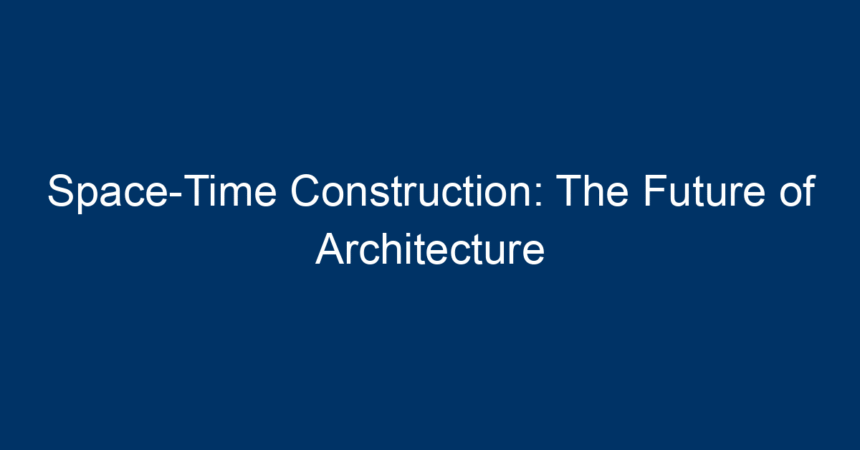Introduction
As we stand on the brink of a new era in architecture, the concept of space-time construction is rapidly transforming the way we design and envisage our built environment. Traditional architecture has always centered around the principles of durability, functionality, and aesthetic appeal. However, as we delve deeper into the realms of technology and theoretical physics, a novel synthesis emerges—an architecture that not only recognizes the physical dimensions of space but also integrates the dynamic nature of time. But what does this mean for the future of architecture? Let’s explore the intricacies, potential, and implications of space-time construction.
Understanding Space-Time in Architecture
1. Theoretical Foundations: What is Space-Time?
Before we can delve into space-time construction, it’s essential to understand the concept of space-time itself. In physics, space-time refers to the four-dimensional continuum that combines the three dimensions of space with the fourth dimension—time. This framework allows us to experience and understand our universe in a more holistic manner.
In architecture, this concept can manifest in various ways. From designing buildings that adapt to environmental changes to creating spaces that evolve based on human interaction, the application of space-time principles can redefine modern architecture.
2. Historical Context: Architectural Evolution
Throughout history, architecture has undergone several transformations—from ancient structures enduring the test of time to modern skyscrapers pushing the limits of engineering. Artists and architects like Frank Lloyd Wright and Zaha Hadid made significant strides in reinterpreting the relationship between space and structure. However, the urgency for sustainability, adaptability, and technology integration marks a pivotal shift towards space-time construction.
3. The Role of Technology
Advancements in technology have played a vital role in space-time construction. Cutting-edge tools such as Building Information Modeling (BIM), 3D printing, and augmented reality are revolutionizing architectural design. These technologies enable architects to visualize projects in a multidimensional space, allowing them to simulate how buildings will interact with their environments over time.
The Principles of Space-Time Construction
1. Flexibility and Adaptability
One of the core tenets of space-time construction is flexibility. Buildings designed with adaptability in mind can transition through different functions over time. For instance, a community center could evolve into a multipurpose space during different seasons or events. This not only maximizes the use of the space but also supports sustainable architecture by reducing the need for new constructions.
2. Sustainability and Resource Management
Sustainable architecture is key in addressing the environmental challenges of our time. Space-time construction emphasizes using materials and designs that minimize resource consumption and energy use. Reclaimed materials, solar technology integrations, and green roofs are just a few examples of how architects can create spaces that coexist harmoniously with their surroundings.
3. Time as an Element of Design
Time is often overlooked in traditional architectural designs; however, embracing it as a critical design element can lead to innovative solutions. For instance, architects can create structures that respond to seasonal changes, such as buildings that draw in light during the winter months and provide shade in the summer. This thoughtful integration of time can drastically reduce energy expenses while enhancing occupant comfort.
The Impact of Space-Time Construction on Urban Development
1. Smart Cities: The Future of Urban Planning
As cities around the world grapple with rapid population growth and climate change, smart city initiatives are emerging as a viable solution. Space-time construction principles are at the forefront of this movement, promoting designs that incorporate real-time data analytics to optimize city planning. Smart transportation systems, responsive public spaces, and energy-efficient buildings can all coexist within urban landscapes informed by space-time concepts.
2. Preservation of Cultural Heritage
Space-time construction also addresses the delicate balance between modernity and tradition. As urban areas evolve, preserving historical landmarks while incorporating progressive designs becomes increasingly important. Creating spaces that honor cultural heritage while adapting to contemporary needs ensures the identity of communities remains intact.
3. Economic and Social Benefits
Investing in space-time construction can yield significant economic benefits. Adaptable structures can decrease the costs associated with building maintenance and operational inefficiencies. Furthermore, such buildings can contribute to social cohesion by providing spaces that foster community engagement, interaction, and inclusivity.
Challenges and Considerations
1. Technological Barriers
While advancements in technology have opened doors to space-time construction, there remain challenges, including the need for extensive training for architects and builders. Integrating new technologies into traditional practices can create resistance within the industry.
2. Funding and Investment
Funding remains a barrier to the widespread adoption of innovative architectural practices. Investors may be hesitant to finance unconventional designs without clear short-term returns. Highlighting the long-term benefits and sustainability of space-time construction is essential in overcoming this hurdle.
3. Regulatory Frameworks
Existing building codes and regulations may not fully accommodate space-time construction principles. It’s crucial to work collaboratively with policymakers to adapt these frameworks to support innovative designs that reflect 21st-century needs.
Conclusion
The future of architecture is undeniably promising with the integration of space-time construction principles. This approach not only challenges our understanding of design but also fosters sustainability, adaptability, and efficiency in our ever-changing world. As architects, policymakers, and communities begin to embrace these transformative ideas, we can move towards creating spaces that are not merely structures but living environments that evolve alongside us.
Actionable Insights
-
Embrace Technology: Invest time in learning and utilizing advanced design tools like BIM and 3D modeling, which can help visualize and construct adaptable spaces.
-
Prioritize Sustainability: Choose eco-friendly materials and designs that promote energy efficiency and lower carbon footprints in every architectural project.
-
Engage Communities: Collaborate with local communities to tailor spaces that meet their evolving needs over time, fostering social interaction and engagement.
-
Advocate for Policy Changes: Work with local governments to improve regulations and codes that support innovative architectural practices that align with space-time construction principles.
- Stay Informed: Keep abreast of emerging trends and technologies in architecture to continually adapt your practices and designs for the future.
In this transformative era, space-time construction offers not just a novel approach to design, but a comprehensive philosophy that has the potential to redefine the essence of our built environments. Let’s harness its potential for a sustainable, adaptable future in architecture.




